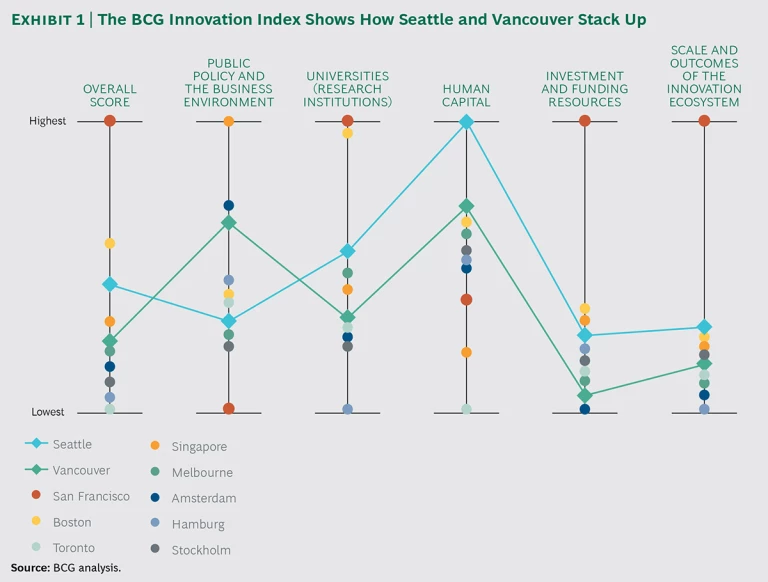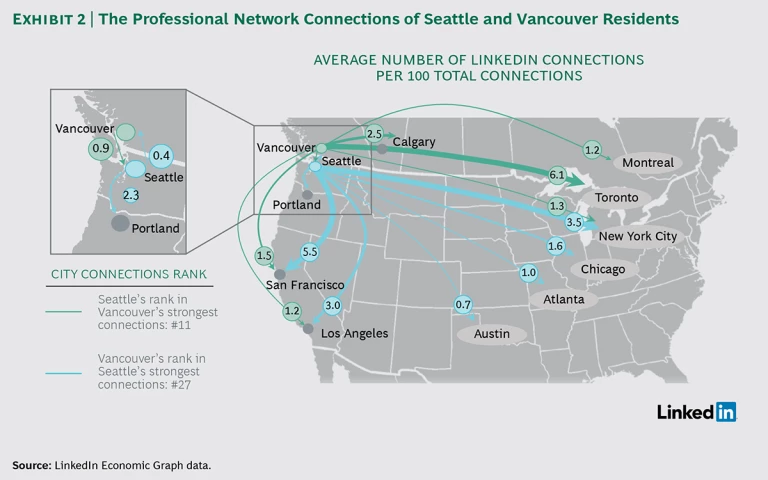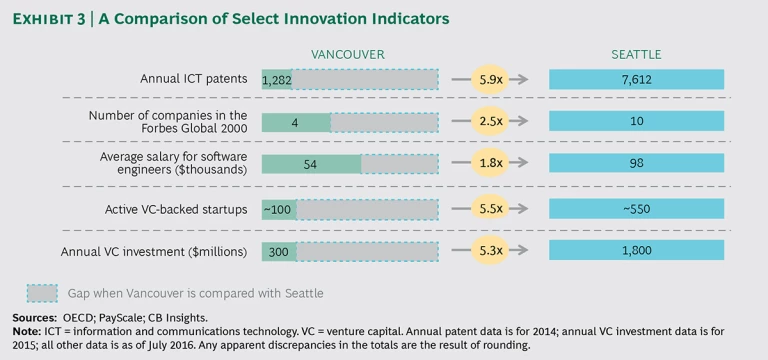Seattle, Washington, and Vancouver, British Columbia, have much in common beyond their Pacific Coast location. These dynamic, culturally vibrant cities are also hubs of innovation. In recent years, they have become meccas for some of the best and the brightest in leading economic sectors—those who, in the words of one regional business leader, “seek livability and proximity to nature as much as they do professional success.”
Endowed with more than just an educated, skilled workforce, both cities are also known for their academic institutions and forward-thinking public policies. These assets have created a fertile environment for innovation. World-class companies—the likes of Microsoft, Amazon, Boeing, Telus, Electronic Arts, and Industrial Light & Magic—power regional innovation that has ignited growth in sectors such as software development, cloud computing, space exploration (in Seattle), and visual effects and computer games (in Vancouver).
Yet although only 120 miles separate the two cities, data shows that their level of connectedness
A cross-border partnership can become the catalyst that advances economic prosperity across all income levels for both Greater Seattle and Greater Vancouver. As innovation increasingly drives economic growth and wealth creation, we believe it is time to take a fresh look at fostering the development of the Cascadia Innovation Corridor, a regional innovation zone.
This report explores the merits of regional collaboration and the potential for partnership between Seattle and Vancouver. (See “About This Report.”) We evaluate the new global landscape, analyze the two cities’ strengths and opportunities, and share key learnings from other city collaborations. Finally, we lay out ideas for how a Seattle-Vancouver partnership may come to life.
ABOUT THIS REPORT
In the spring of 2016, leaders from Microsoft, the Washington Roundtable, the Business Council of British Columbia, and The Boston Consulting Group began working together to explore the possibility of greater economic collaboration between the Greater Seattle and Vancouver regions. Inspired by the rise of innovation hubs around the world, business and government leaders in both Seattle and Vancouver see great promise in building on the region’s strong foundation of innovators and innovation assets. This report summarizes the impetus behind this exploration, our findings, and proposed next steps.
The New Innovation Landscape
Large economic gains are increasingly going to global cities and regions that are centers of innovation, such as San Francisco, Singapore, and London. This phenomenon is driven in part by the tendency of innovation-oriented jobs to disproportionately benefit local economies. One notable study
Metropolitan city regions are, in fact, fast becoming the locus of global competition: worldwide, 300 metro areas
By working in alliance, though, Seattle and Vancouver could better address these challenges. Their individual strengths in a number of areas complement each other, and if developed jointly, these strengths could generate greater economic and social gains for both. Through unified action, the two cities could establish self-perpetuating innovation ecosystems able to compete on a global scale. The macroeconomic benefits from cluster growth could be even more substantial, as Michael Porter noted more than a decade ago. As clusters become larger,
Capitalizing on their complementarities to achieve greater global prominence will, however, require deliberate, sustained action—not only in the way Seattle and Vancouver foster innovation but also in the way the two cities work together. Strengthening the connections between the two regions would be a good start and would begin to reduce the perceived distance. By “connections,” we’re referring to the gamut of interactions between the regions: partnerships between public- and private-sector entities, joint academic research, and even cross-border relationships among individuals. But stronger connections alone will not be enough.
Accelerating the development of a world-class innovation corridor will take transformational efforts: transportation initiatives to shrink the not insubstantial distance between the two cities, immigration policies that enable people to travel between the two cities more freely, and the commitment of capital to invest in new ideas and new enterprises. It will also require an emphasis on continuing education to promote career mobility and ensure access to opportunity for all residents. (For more on the importance of inclusive economic growth, see “ Saving Globalization and Technology from Themselves ,” BCG Perspectives, August 2016.)
Innovation Enablers: How Cascadia Stacks Up
To better understand what a transformation would require in the Cascadia region, we first benchmarked Seattle and Vancouver against a selection of global cities with similar demographics and economic profiles, evaluating to what extent the two cities’ innovation economies are connected. We also compiled key learnings from other cities’ economic development partnerships. Although we looked at broad economic indicators, we focused on the innovation economy and the information and communications technology (ICT) sector.
Benchmarking. In our benchmarking analysis, we examined five factors that are commonly considered innovation enablers: public policy and the business environment it promotes, universities (research institutions), human capital, investment and funding resources, and the scale and outcomes of the innovation ecosystem. We ranked Seattle and Vancouver against eight other leading cities on the basis of a composite of 71 quantitative metrics for these five enablers.
Impressively, Seattle and Vancouver ranked first and second, respectively, in human capital, thanks in large part to their high marks in livability and well-educated populations. Seattle scored higher than Vancouver in universities, investment and funding resources, and scale and outcomes of the innovation ecosystem; Vancouver ranked well above Seattle in public policy and the business environment, owing to the city’s favorable tax structure and more open immigration policy. (See Exhibit 1.)
Innovation Enablers: How Cascadia Stacks Up
This research suggests that together, Seattle and Vancouver have the potential to boost their combined performance across all the innovation enablers. In areas of unilateral strength, a partnership may allow the leading city to promote the development of the other. And where both have room to improve, scale advantages could become a mutually beneficial enabler. For example, collaboration across the three leading research universities—the University of Washington, the University of British Columbia, and Simon Fraser University—could perhaps create a more thriving research environment. Connectedness. The low level of connectedness between the two cities, however, is a serious impediment. Today, few companies or public-sector entities collaborate across the border. According to data from LinkedIn, there is a similarly low level of connection between individuals in Seattle and Vancouver, and talent does not flow freely between the two cities. For example, Vancouver’s LinkedIn members’ connections to members in the Greater Seattle area account for less than 1% of their total connections; in fact, Vancouver’s members have more San Francisco connections than Seattle connections. Among Seattle members, the figure is even lower; only 0.4 percent of their total connections are with Vancouver individuals. Seattle is more connected to Atlanta than to its neighbor to the north. (See Exhibit 2.)
This lack of connectedness impedes the cities’ ability to fully realize their growth potential, particularly in scale growth. Studies have shown that concentrations of population spawn network effects. As the population in a region doubles
Growing Together: The City-Pair Approach
To gain a deeper perspective on the opportunities for cooperation between Seattle and Vancouver, we examined eight city partnerships around the world, including domestic and cross-border partnerships. Not surprisingly, the proximity of cities is a common foundation for collaboration, and many city pairs have historical and cultural similarities that form the basis of trade. As we observed in the Greater Copenhagen and Skåne Region (formerly known as the Oresund Region), a transnational area spanning Denmark and Sweden, these relationships overcome the challenges created by international borders. We also found that the most common types of partnerships were those sharing human capital and infrastructure support. Cities that collaborate successfully work together to facilitate the free flow of workers, sometimes even cooperating to augment talent pools and connectedness. These cities also ensure that their infrastructure, particularly transportation infrastructure, facilitates that flow.
In many instances, the collaboration starts out as an emphasis on one or a few sectors and then grows to spread across multiple industries. Some city pairs leverage their similarities across certain sectors to achieve scale, while others pool distinct expertise together for economic diversity. Helsinki and Tallinn, for instance, seek critical mass through combined efforts in innovation fields, including ICT, health technology, and clean technology. Most important, we found that the success of the joint efforts is often predicated on a strong coordinating body endowed with legitimate power and the ability to invest. The Research Triangle Foundation of North Carolina, which serves the Raleigh-Durham-Chapel Hill hub, stands out as an inspiring case. This private, not-for-profit organization manages its cluster’s strategic planning, development, investment, and branding, thus ensuring the engagement of its stakeholders.
The Cascadia Opportunity. Combining insights from other successful partnerships with our findings about each city’s strengths and weaknesses, we identified several areas to explore for building on complementarities and grouped them using the five innovation enablers:
-
Human Capital. Seattle and Vancouver each possess a strong pool of skilled innovation workers, yet both still experience gaps in sourcing talent. Although meaningful change may be difficult to achieve, both cities could benefit from a reduction in the obstacles to accessing talent in their neighboring market.
-
Universities. Collaboration and research partnerships could help each city’s academic institutions pursue innovation, in turn raising their global profiles. Both Seattle and Vancouver lag their counterparts in San Francisco, with 38% and 77% fewer academic citations
10 10 BCG analysis using Thomson Reuters’ Journal Citation Reports database. , respectively. -
Public Policy and the Business Environment. The two cities can share best practices across a number of areas in order to create a more business-friendly domain. Both Seattle and Vancouver, for example, have strong economic and cultural ties to Asia. By leveraging these connections in a concerted way—through joint policies to attract foreign investment or a shared branding effort—the cities could realize even greater benefits from these relationships.
-
Investment and Funding Resources. The availability of local capital continues to be a challenge for early stage and growing businesses in both cities. The average amount of assets under management
11 11 BCG analysis using CrunchBase and PitchBook data. at Seattle’s largest venture capital firms, for example, is only about half that of their San Francisco peers. Formal, joint-funding efforts could garner more interest, bring local wealth off the sidelines, and in turn raise the cities’ visibility to other funding sources, including direct foreign investment. - Scale and Outcomes of the Innovation Ecosystem. Seattle has a variety of assets—from its startup support network to its multinational companies—that can complement Vancouver’s innovation ecosystem. Vancouver, whose business base represents less than $200 billion in enterprise value
12 12 BCG analysis of Capital IQ 2015 data set on enterprise value of publicly traded companies, which is based on the location of their primary headquarters. Vancouver’s upper limit refers to total British Columbia base. , could expand its scale significantly through more cross-pollination with Seattle and its near $1 trillion ecosystem.
Overcoming the Challenges to Collaboration. Despite their many complementarities, Seattle and Vancouver face several challenges in establishing an innovation corridor. One hurdle is that the international border restricts the free flow of talent and hinders travel. Differences in scale are another: in measures of innovation inputs and outputs, Seattle is generally substantially larger than Vancouver. (See Exhibit 3.)
A deliberate effort to heighten collaboration, along with strong leadership, would certainly solidify the connections between the two cities, while helping to develop their complementary strengths. However, achieving the scale required to match the level of leading innovation hubs calls for a different approach, one that could ultimately foster more transformative endeavors. Steps to reduce friction in the flow of talent, for example, could be a longer-term objective of partnership. But a number of other strategies could be implemented well before that. To unleash local investment in the innovation economy, Seattle and Vancouver might work to encourage anchor innovator companies to form regional innovation funds that raise capital from high-net-worth employees and alumni or from other sources of local wealth. Reducing distances and travel times between the two cities—through, for example, a high-speed rail network—could go a long way in encouraging companies, institutions, markets, and individuals to connect. Other possibilities include training programs dedicated to developing local talent for innovation-focused careers or a bilateral “smart cities” initiative that promotes the development of Internet of Things technologies in the two cities’ public spaces, systems, and infrastructure. These are only a few of the many kinds of initiatives that could have a transformative impact. Even exploring more targeted opportunities in specific industries or in subsectors where the cities are comparatively strong, such as clean technology, life sciences, and computer gaming, could help the cities foster large-scale change.
What’s Next?
To bring such long-term, transformative opportunities to life, Seattle and Vancouver could start by taking action now to amplify the level of connectedness between their leaders and key institutions. A working group could be formed to spearhead this broader initiative by prioritizing, promoting, and engaging key stakeholders in the region. To fuel commitment and momentum, we have begun to identify pragmatic near-term actions that could work to foster connectedness from the inside out.
Among some of the many possible actions are establishing a formal academic research network (perhaps borrowing insights from the Research Triangle model), coordinating educational programs that prepare workers to participate in the innovation economy, fostering relationships both within startup communities and between investors and entrepreneurs to increase the availability of capital and other support, or enhancing transportation connectivity in low-cost ways, such as by resuming a “nerd bird” seaplane between Coal Harbour and South Lake Union. There are many more near-term ways to bolster connectedness—some already identified, some yet to be conceived.
The opportunities identified here represent the tip of the iceberg. The true power of the region lies in the people who create and drive new innovation. A working group can only do so much. The Cascadia Innovation Corridor will only realize its promise if engaged stakeholders in both cities commit to bringing this vision to life, in ways big and small. We invite you to bring your ideas, your support, your energy, and your connectedness to this effort.
Acknowledgments
The authors wish to thank the Economic Graph team at LinkedIn for contributing crucial data and analysis to inform our research. In addition, the authors extend their thanks to the more than two dozen business and government leaders who graciously donated their time to share their perspectives. Unfortunately, with so many contributors, it is not possible to acknowledge each of them here individually. But we cannot overstate how valuable their insights were to this project. The authors appreciate the contributions of their BCG colleagues Vasu Subrahmanian, Travis Peoples, Yale Zeller, and Amanda Provost. Finally, they thank Jan Koch for her writing assistance and Katherine Andrews, Gary Callahan, Angela DiBattista, Kim Friedman, Trudy Neuhaus, and Sara Strassenreiter for their contributions to editing, design, and production.










